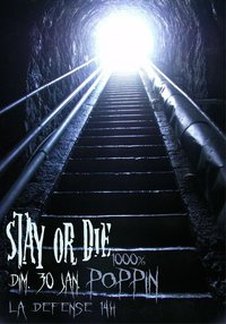 P. Diddy once told me to either Vote or DIE! So naturally I voted. 50 Cent lives by the mantra "get rich or die trying." Those Vitamin Water ads suggest which way his scale is tipping. And here in Paris, our good friend-of-the-blog and celebrated Vertifight organizer Youval has commanded that I "Stay or Die!" While the act of staying seems rather mundane and disproportionate to the severity of death, I must admit that it was an arduous task. I failed to stay, so I died… ….on the dance floor. Last week, once again Youval commandeered the closed shopping space beneath La Defense (Paris' financial district) for a literally underground street dance competition. This time the contest categories were in Popping, House, and All Styles. This time "Stay or Die" was the format. And this time, for the first time in Paris, I competed. I showed up nervous, anxious, and eager to prove myself. There again stood an intimidating mass of 100 young hip hop heads, forming a circle around a portable amp hooked up to an mp3 player. Surrounding them were closed clothes stores, some with signs that read "Skateboarders and dancers, please don't touch the windows." I was among the first group of 6 people called into the circle. My beating heart almost burst out of my chest... I thought we would do a round of preliminary selections in which each person had 30 seconds to get busy, and the judges would select one from the group to advance into the main competition. But then something crazy happened. Youval called out 6 more poppers to the floor. The second group of 6 stood before me at the other side of the circle. "I don't understand," I complained to my friend Mohamed. "What do I do?" "You battle."
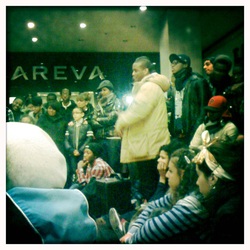 Judge Franquey looks on in his fat North Face. So it was an improvised crew battle, I thought. Each crew sent out one dancer at a time for their moment in the cypher. But unexpectedly, after every other solo, the judges pointed to a side, picking a winner. Even though I don't speak the language, the people there could still read on my face: "HUH??"
One by one, members of the opposing crew sat down, having lost to those on my side. I was the fourth person to go, suddenly aware that this was survival of the fittest. My opponent was alright but not incredible. I smelled blood, hungry for a kill as the adrenaline thrust me into the cypher. I started unloading my arsenal, showing technique, character, hunger. And they cheered. It's all I could've asked for-- respect from the melange of African, Arab, and Asian faces surrounding me. I don't speak French, but I proved to them that I speak dance.
Pretty soon though, overwhelmed by the unexpected cheers, the adrenaline, the pressure, I got lost in that cypher. My mind went blank. The longer I was out there, the more I froze and the quieter the crowd got. I rushed out of the cypher, and looked to the judges. Two pointed to me, one pointed to my opponent. Phew, I got to stay.
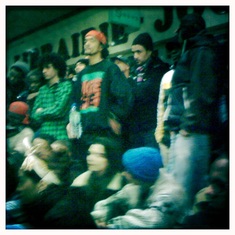 The hyped audience. A few more mp3's into the battle and only one man stood on the other side of the cypher while five on my side remained. He paced brazenly back and forth, staring each of us down like the warrior he was. His name was Amour, the French word for "love." One by one, my crewmates stepped into the circle with Amour. One by one they fell. It was like marching up to the guillotine (French historical reference!). Suddenly it was my turn. I knew resistance was futile, but with nothing to lose, I felt liberated. I danced hard and I had fun with it. I laughed during my own solo. The crowd sensed my liberation and enjoyment, and they cheered. But they cheered even more for Amour. So I died, and he stayed, the last man standing in the circle. Love really does conquer all. Afterwards, friends and strangers alike high-fived me to commend and appreciate. After months in Paris, documenting the lives of others, I finally expressed myself to them. In turn, I felt connected, intertwined into the fabric of their local culture. I'm finally a part of something. I think I'll stay a while.
Here's an example of a past "Stay or Die" battle hosted by Youval. The last person standing from each battle ultimately goes on to face the other survivors.
 It was the year 2000. Scattered among tapes in my friend's basement in New Jersey, one VHS caught my eye like a diamond in the rough. On the cover graffiti block letters hovered over an ill drawing of a b-boy doing headspins. It was Battle of the Year 1998, and it felt like finding buried treasure in your own backyard: pure gold and straight underground. I had never seen breakin like this before. The basement party cyphers and subway station performances did not prepare me for BOTY, the world championships for b-boy supremacy. Live on stage in Offenbach, Germany, France's The Family faced California's Rock Force Crew in the heated controversial final, Japan's Spartanic Rockers taking "Best Show" honors. Not only an introduction to a culture, it was a gateway to a whole new world. A decade later, BOTY continues to be the biggest and most legendary b-boy event. It's kept the Bronx dance style alive and evolving, providing inspiration for aspiring b-boys in every corner of the world. It's also the focus of Benson Lee's 2007 documentary Planet B-Boy (whose image I sampled for this blog's banner) and is the inspiration for his upcoming feature.
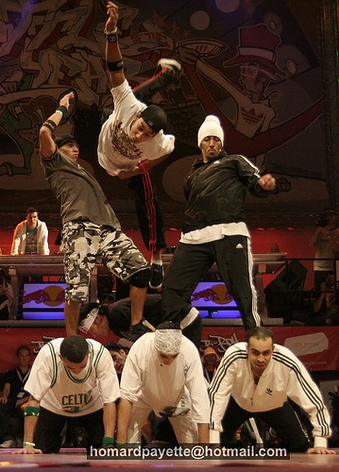 The last BOTY France won was 2006 when Vagabonds placed 1st Celebrating its 21st anniversary this past weekend, BOTY abandoned its home country of Germany for the first time and relocated to Montpellier, France. This changing of the guard marks a major turning point for France's b-boy scene. It's an acknowledgement of France's stature as breakin powerhouse, a country that's produced BOTY champions four times, 2nd place finishers twice, and "Best Show" winners twice. The only country more dominant is Korea, having won six times in the past decade. The event has helped launched the careers of France's best dancers, earning them worldwide renown. "It [BOTY] gave me a name in the world of b-boying," says By of Fantastik Armada, 2004 runner-ups. France's best known street dancer Salah, winner of the first season of Incroyable Talent (France's version of America's Got Talent), made his international debut in the 1998 BOTY final against Rock Force. BOTY started out in Hanover, Germany in 1990 with just over 500 spectators and representation from Germany, the UK, and Switzerland. This past Saturday, the annual event hosted 14,000 in Montpellier's ARENA with crews from 19 countries worldwide (having won regional or national qualifiers), from Israel to South Africa to Brasil, competing for the title. Korea notched another victory in their championship belt as Jinjo crew overwhelmed Japan's Mortal Combat. France's La Smala finished a respectable fourth, but certainly disappointing for the hometown crowd.
Major French TV network Canal covered the event live over the internet, complete with pro-sports-like commentary and interviews. The move to France has certainly increased the event's live audience but new problems have emerged. The MCs now have the cumbersome task of hyping the crowd in English and in French. While English was no problem in Germany, it's obvious that the crowd in Montpellier has a lower threshold for it. And already there's backlash from the b-boy community at the different atmosphere in France's BOTY. On the global forum bboyworld.com, one commenter advocates for a return to the past: "It was the worst crowd in the history of BOTY, bring it back to Germany next year." Others described this BOTY as the "weakest" and "horrible," while another clamored for majority English MCing. BOTY is slated for at least one more year in Montpellier. For the French b-boy scene, it's still a relished honor to host, to attend, and to compete. "Ever since I was a kid," Lilou, of 2003 champions Pockemon, explains, "I dreamt of being on that stage." Next year, France will have one more opportunity to own that stage. Here's a great short documentary on the 10th anniversary of BOTY's qualifications and what it's meant for the local scene:
Finally, something uniquely French. It's electro dance, a style of street dance born from the same country that gave the world Daft Punk. It obviously draws from vogueing, raving, wacking, and hip hop, but there's no doubt electro dance is in a world of it's own. And unlike its ancestors, it stresses routines in every round just as much as solos. Here's an inside look at a recent competition called Vertifight with insights from organizer Youval.  October's winners will represent France atthis main event in 2011 According to this blog, techtonik (but is it the same as electro dance?) originated mainly from the dance clubs in Southeast Paris, particularly Metropolis. But what's interesting is that in the context of Vertifight, all the dancers probably can't get into these clubs since they're still struggling with high school pre-calc. Youval mentioned that many youth took to electro dance via YouTube clips, which is probably also how Vertifight and the dance itself have successfully been exported all over the world (except the US). Also interesting to note is that Youval considers electro dance the little brother of voguing. He can lay that claim as he is indeed one of the original and only voguers in Paris from the 1980's. But he maintains that his culture is none other than hip hop, as he's also from the first generation of b-boys and poppers. When he speaks about electro dance's misrepresentation in the mainstream media as "techtonik," I sense that he's linking it with the history of breakin' which outsiders termed "breakdancing" during its era of exploitation. But like breakin, electro dance has endured in the underground.
Below is a little recap I made of the this past weekend's over-sized Paris street dance competition Who Iz Who: A few interesting things to point out about this particular competition: - The 2-day event hosted contests in the so-called traditional Hip Hop dances of Popping, Locking, Breaking as well as contests in Hip Hop, a separate category for Krumping, House dance, and Vogue.
- Each contest averaged about 70 entrants each, and more than 100 for Popping and about 200 for Hip Hop!
- Dancers came from all over France, Germany, Italy, Sweden, and maybe a handful from the US (do I count as US or France?).
- There were judges for each particular style of dance, of whom the majority were from the US. Clearly the cultural imperial power still making its presence felt and deciding what's considered good.
- Rumor has it that the original Krumping judge scheduled to come Tight Eyez, Krump pioneer made famous by the documentary Rize, bailed because he thought Who Iz Who was too commercial!
- Indeed, many at the event grumbled that the event costway too much to attend and was merely put on to make dollar$$$...woops, I mean euros. For this reason, some people didn't bother to show up for Day 2 which cost 25 euros a ticket.
- Another rumor circulated after the event was over that a bag full of thousands of euros in cash payment for the DJ's and judges went mysteriously "missing."
- EDIT: Also note that the final battles took place at Palais des Sports which is a concert venue for the likes of Elton John, Boyz II Men, and the Blue Man Group. Could you imagine anything e
And what's the deal with all the Krumping here in Paris? Why do I have to cross the Atlantic to see this American-made dance? In NYC, I've only seen this LA street dance performed mockingly (east coast, west coast bias? perhaps). It's surprising that out of all the newer street dances in the US, from Get Lite and Flexing from New York to Turfing in Oakland to Jooking in Memphis, the ones that have really taken hold here, Krumping and Jerking, are both from LA. Something tells me it has a little something to do with that Hollywood magic. Then again, maybe in my ignorance, I simply haven't seen the rest. I do however appreciate that the hyper agressive Krumping battles at this event were always followed by deliberately effeminate Vogue dancing (see the incredible Javier Ninja at the end of the vid for an example).
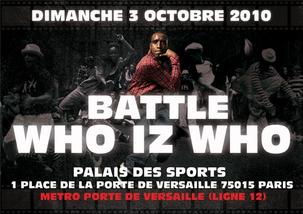 Who Iz Who, the fifth annual Paris street dance competition will be taking place this weekend. After the warm-up battle that took place at La Defense two weekends ago, this is the main event. 28 dancers chosen to compete from over 600 participants from all over Europe in popping, locking, wacking, house, and hip hop. 4000 spectators will converge at the Palais des Sports tomorrow at 3PM. Get tickets here. A taste of what's to come:
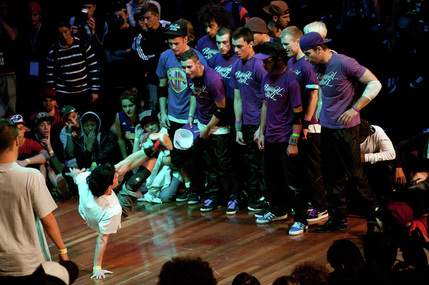 Breaking crew battle @ IBE 2010 Last week's Who Iz Underground took over a small alcove in a deserted section of a train station in Paris. This past weekend's Notorious IBE (International Breakdance Event) took over an entire town in Holland! It was B-boy city in the Netherlands as the IBE had set up shop in 8 different venues all over the small city of Heerlen for the whole weekend. (Although that entire Saturday I thought we were in Rotterdam until a Dutch friend kindly informed me otherwise. "Wait, what do you mean we're not in Rotterdam??") From an open air venue in the town square to their major concert hall to their local university to every other multipurpose space available, the IBE had completely taken over.
Heerlen had clearly embraced the huge international event which boasted over 2,500 b-boys and b-girls from 30 different countries (mostly European). The mayor of the town officially welcomed the IBE-ers at the opening ceremony. Locals integrated into the crowds and watched cheerfully. TV news crews covered the spectacle (and interviewed yours truly!). And there is no question, that like any other industry convention, the IBE was a boon for local businesses and the local economy, which is good news for this struggling city that l ost 60,000 jobs when coal mines were closed several decades ago. I arrived Saturday afternoon following a four-hour cramped car ride at the back of a VW Golf with four other dancers from Paris. We left from Porte de la Chapelle at 9am where throngs of other Paris dancers were boarding buses all headed for Heerlen. It was mass exodus for the promised land of street dance culture (at least for that weekend). A Senegalese-French popper I met at Who Iz Underground had invited me along for the excursion. With us in the car was a b-boy, a Hip Hop dancer, and another popper, all of whom were of African or Arabic ethnicity. We went on to meet up with other French dancers at IBE from Paris and Lille, few of whom I would guess were ethnically French.  The main venue on Saturday @ IBE 2010 While the French street dance scene is comprised mainly of those from immigrant communities, this did not seem to be the case for the busloads that arrived from the UK, Italy, Portugal, Scandinavia, the Netherlands, which tended to be more mixed or just predominately white. Hip Hop culture in every country and every city takes root in different ways, varying according to who is growing that particular scene. Even in the US, the traditional Hip Hop dances like breaking and popping are practiced by Latinos, Asians, and whites. In contrast, the newer Hip Hop dances like Flexing and Jerkin' are predominately practiced by Black youth. Out of all the Parisian dancers I met, only one was living off the culture as a professional dancer. In the mix were also: - an air conditioner repairman
- a computer engineer
- an airport worker (unclear as what exactly)
- a theater director
- a marketing manager for a major pharmaceutical company (Which one? Hint: they make a drug for erectile dysfunction.)
- a college student
For the most part, English language ability correlated with occupational status, except in the case of the professional dancer who actually spoke English the best. Ironically though, he had gone to college to study international business. Walking down the street, based on our baggy jeans and the color of our skin, it would be easy to assume that we were ghetto youth when in actuality, we defied any single socio-economic class, any single level of education, any single ethnicity. We were as diverse as the Hip Hop culture we embraced. Hooray for the subversion of prejudice and unity through diversity!
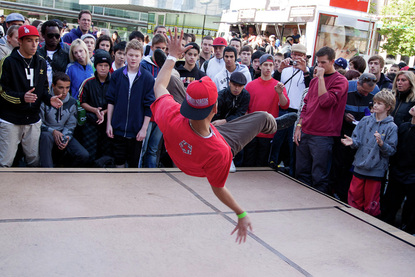 Breaking in the Heerlen town square Language and Unity As the professional dancer told me in his British-accented English: "Big events like these are really great 'cuz they bring people together, and just because we don't speak the same language, we still communicate to each other through dance." Despite this heart-warming account of a boundary-less Hip Hop-unified world, I could still sense the nationalist pride underscoring the event. Dancers repped where they were from to the fullest. They waved flags and debated which country had the strongest talent, which country was on top. And to me it seemed that France was. Whether in the breaking, popping, locking, Hip Hop, or house battles, their presence was felt. But even within the French contingent was a huge dividing line between Paris and Lille. The cities clashed on the dancefloor, with respect and admiration yes, but with bitter rivalry as well. It was like the South Bronx feuding with Queens. In the end though, it hardly mattered. Everyone gave pounds and exchanged hugs, expressing their eagerness for the next city and next event they would see each other at. As our driver, the computer engineer explained to me: "I don't really go out to clubs or anything. I just practice during the week and travel almost every weekend to battle." This is street dance life.
Coverage of Day 3 of the IBE from IBE TV:
On Sunday I travelled to La Defense, the major business district of Paris located at its Western border. Though architecturally fascinating since the district's glass and steel skyscrapers sharply contrast with the rest of neoclassical Paris, I was not there to stare up into the sky at huge buildings. I was interested in what was below them. I had found out several days prior that a small street dance competition would be taking place at La Defense train station. I came across this intel while on Facebook researching another street dance competition, Who Iz Who?, a massive battle taking place in Paris in two weeks. Organizers expect over 4,000 street dancers from all over Europe to converge on the City of Lights for their chance to shine. A smaller battle, Who Iz Underground, would take place at La Defense in anticipation of this main event. When I arrived at the station, as usual, I had no idea where to find the scene. I wandered all over the massive station and above it for nearly an hour, seeking some hint of Hip Hop. The Facebook announcement for the event simply said La Defense; clearly this was a rendezvous for insiders. I finally came across a pair of athletically-built teens, suited up in slim fit jeans, Pumas with fat laces, and fitted caps, backpacks slung over their shoulders. They seemed to be b-boys (or breakdancers), so as is routine for me at this point, I followed them. They walked down an empty corridor, passing rows of closed shops and boarded up walls from ongoing construction, Slowly, however, there began to be more youth along the way, lacing up and stretching out--an auspicious sign. I followed them around a corner, and I was greeted by a sight to behold: a dense mass of Hip Hop kids crowded into a tight recess of the station and completely engrossed by the dancers at the center of the cypher. I have never experienced anything quite like it. I've been to street dance competitions all over the U.S., Japan, Germany, and Sweden that take place in concert venues, clubs, gymnasiums, and even churches. These events often charge entry and are formally organized with fiscal sponsors and everything, much like concerts, but this was something different. This was more like a flash mob, a takeover of semi-public/semi-private space, where the 100 or so people merely assembled at the given time and used the available space to carry out a cultural ritual with or without permits. There was no money exchanging hands, no sponsors or banners, no spectators or tourists, no seats. There wasn't even a DJ with turntables. Instead, a man at the center of the crowd scrolled through his iPhone playlist and blasted beats through a guitar amp. It all felt very improvised, very Hip Hop. I wouldn't have been surprised to see that amp jury rigged to some cables and stealing electricity from a streetlight. This guerrilla-style attitude manifested itself into the intensity of the crowd as everyone there watched with bated breath, ready to erupt for every bold new move, every athletic display of creativity. The energy was electric. They also didn't seem to notice or simply didn't care when alarms went off every time someone got too close to the closed shops at this end of the station. At the same time though, the police never showed up either, and so the competition continued unbeknownst to the tourists above ground and the travelers passing through the station. I was later told that like Les Halles, street dancers congregate at this far end of La Defense every other night of the week after all the businesses close. They use storefront windows as mirrors, creating makeshift studios at every stall. The dancers are peaceful and so are hardly ever dispersed by the police or business owners. The battle going on Sunday simply manifested what has already been going on there for years. That night, one-on-one tournament-style competitions took place in three street dance styles: popping, house, and what they called "new style" (contemporary Hip Hop dance). The winners of each competition, all of whom I perceived to be of Arabic ethnicity including at least one Mohamed, received a ticket to the Who Iz Who? main event in two weeks which is worth about 20 euros. The dancers competed, then, mainly for bragging rights and for the love of dance. The event itself obviously did not produce any profit and served only as an outlet for cultural expression. Ironically, all this transpired right beneath the financial district of La Defense, where a wellspring of community continues to thrive underground.
 While waiting to meet up with a friend outside the Chatelet train station near the center of Paris, my eyes widened when a young couple walked by dressed in the freshest Hip Hop gear. While usually such a sighting is unremarkable in an urban setting, these two caught my attention because their bright purple and black outfits matched, from their baggy sweats to their fitted caps. The untrained eye might mistake them for a gang, but I could clearly recognize them as street dancers. I watched as they hurried off, and out of curiousity, began following them, hoping they might lead me to a dance performance. They turned a quick corner into an open square, but I wasn't as quick. I lost them. Looking around for signs of bright purple, I scanned the urban landscape for the couple to no avail. But just when I was ready to turn around and leave, I saw rapid movement coming from the balcony of Forum des Halles. Street dancers!
I climbed the stairs to the balcony where I found several groups of young Hip Hop kids dancing in front of the glass of the building's exterior. Just as I'd seen in Tokyo a few years ago, these street dancers practiced their craft using the architecture of city as their dance studio. The glass walls provided mirrors while the balcony provided open floor space. Each group of dancers claimed their individual part of the "studio" where they had hooked up iPods and PSPs to portable speakers. Emboldened by the discovery, I approached one pocket of youth, introducing myself in broken French: "J'habite en New York. Je suis danser...ehh...Foto?" Luckily a couple of the teens spoke more English than I speak French. They were delighted by the request and immediately formed an impromptu cypher to demonstrate their skills, eager to get on camera. They turned up the music (which on portable iPod speakers is about as loud as a walkie talkie) and got down. In their skinny jeans, bright tees, and fat sneakers, they danced one by one to contemporary, minimalist hip hop, doing some heel-toe steps, dropping down to the floor, and grooving back up. The others clapped and cheered as each got in their solo. I asked the ambassador of the group Frank if the dance style they were doing was Get Lite, a dance I'd seen from Harlem. "No, Get Lite is dead," Frank enlightened me. "The last video on Youtube was from 2008. This is Jerkin' from LA." I'd never heard of Jerkin'. Here I was, an American from NYC, the cultural capital of the world, and had no clue what this new American-made dance was. I needed these young folks who have probably never even been to LA to inform me. Wikipedia confirms that Jerkin' started around 2008 in LA, made popular by a song by the New Boyz called "You're a Jerk." Curiously enough, the article likens the dance to that of the French dance called Techtonik. More on this other dance later.
Here I was, documenting this dance, amazed at how it travelled to these youth a continent away, and through this vehicle they found a community, a culture, and a lifestyle. It was a diverse group of youth, composed of different races, ranging in age from 17 to 11. Though they were mostly young boys, there was one female in the group who seemed to be regarded as an equal in this dance. I assumed they were all friends or classmates from the same immigrant neighborhood in Paris, but again I was mistaken. They actually came from all different parts of the city, but generally all from the border. Frank said they found each other through Facebook, and they gather at Chatelet every Sunday to practice. Indeed there is a whole Facebook community of young teenage Jerks in France, with over 3,600 fans. Here they update each other on the latest music, fashion, and dance moves within the culture. They post videos of themselves battling and boast about their respective crews. Judging by the pictures and video, they are emulating the New Boyz to the T. I haven't been able to locate Frank or others on Facebook yet, but I'll definitely be back at Chatelet to learn more.
|





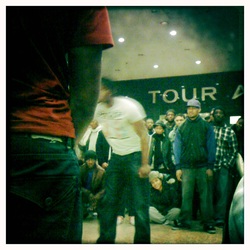
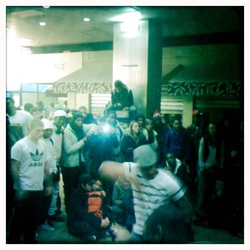
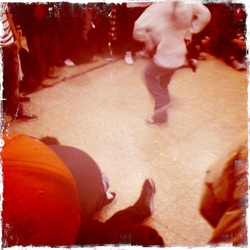
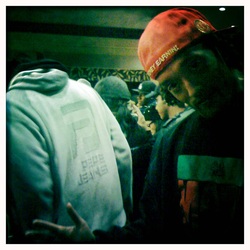








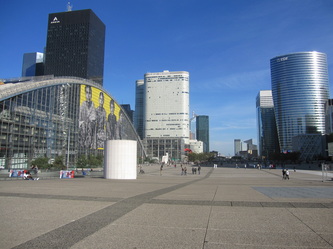


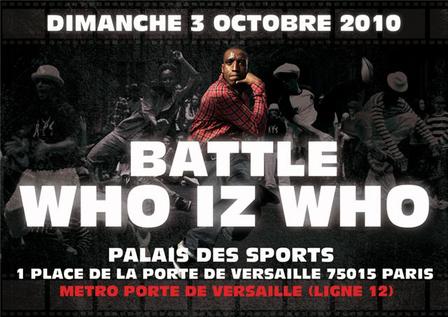

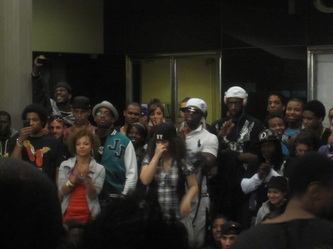

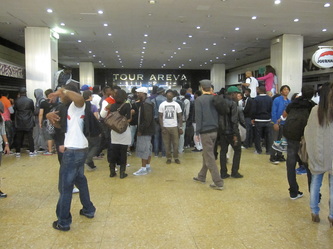

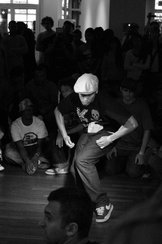
 RSS Feed
RSS Feed